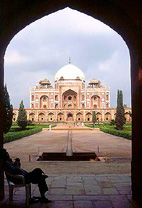
Built in 1570, during the reign of Akbar
Mughal dynasty
Delhi, India
Photo copyright © Daniel C. Waugh, 2001
The first Mughal Emperor, Babur, was succeeded by his son, Humayun (ruled 1530-1540, 1555), who was expelled from after his first decade in power. He fiinally took refuge with the Safavid shah of Persia, who helped him regain Delhi in 1555, the year before his death. From 1562 to 1572, Humayun's Persian wife Hamida Begum supervised the construction of her husband's tomb in Delhi. The architect, Mirak Mirza Ghiyuath, was Persian and had previously designed buildings in Herat (now northwest Afghanistan), Bukhara (now Uzbekistan), and elsewhere in India. The location chosen for the building on the bank of the Yamuna river adjoins the shrine of an important Sufi Chistiyya order saint, Nizam al-Din Awliya. The Chistiyya was particularly venerated by the Mughals; Humayun's son, Akbar, would build his new palace at Fatehpur Sikri next to the shrine of another saint of the Chistiyya order.
The tomb established some of the important norms for later Mughal mausolea. It is set in a geometrically arranged garden criscrossed by numerous water channels and probably representing symbolically a paradise setting. Such typical Persian gardens had been introduced into India by Babur; later they would be found in the Red Fort in Delhi and at the Taj Mahal in Agra. The architectural form of the building is Persian and especially in its main chamber shows some familiarity with the tomb of the Mongol Ilkhanid ruler of Persia, Oljeytu, at Sultaniyya. It is one of a long line of Mughal buildings influenced by Timurid architecture, notably the tomb of Timur (Tamerlane) in Samarkand. Babur was proud of his Timurid heritage and deeply regretted his inability to hold Samarkand. His successors continued to dream of regaining Samarkand and would interrogate visitors about Timur's tomb. Humayun's tomb is the first Indian building to use the Persian double dome; it is noteworthy for its harmonious proportions. As with later Mughal tombs, that of Humayun is set upon a podium or platform. The most obvious Indian features of the architecture are the small kiosks or chhatris on the roof. The building is also noteworthy for its inlaid tile work, carving embodying both Indian and Persian decorative elements, and its carved stone screens.
-- Daniel C. Waugh
 | Whole view of tomb from south |
 | Detailed view of tomb from south |
 | View of tomb from east |
 | Detailed view of carved red sandstone fašade |